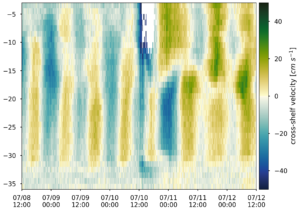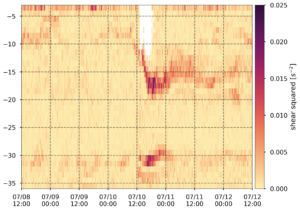-
Currents from Atlantic Shores
Posted on July 14th, 2020 No commentsNow we look more into the why question. We know the surface water cooled significantly during Fay (5-6C), and we know that 70-90% of the cooling was ahead of eye, and that the ahead of eye ocean cooling changed the sign of the air-sea heat flux. But why?
Here Cliff looked more deeply at the currents measured by an Acoustic Doppler Current Profiler (ADCP) on the Atlantic Shores buoy. In the plot below, we rotate the currents into the cross-shore and along-shore framework, and here plot the cross-shore component. Blue represents strong currents towards the coast, green represents strong currents towards the offshore. The y-axis is the water depth of each ADCP data bin in meters.
You can see the storm take over on July 10 after about 12 GMT. There is a very strong jet towards the coast. So strong it maxed out the 50 cm/sec range on the current measurements. Before and after, especially in the bottom layer, you see the 12 hour 25 minute tidal signals.

Next we look at the shear squared also plotted as a function of depth. During the storm, the surface mixed layer is expected to have very little shear, being well mixed, and most of the shear will be concentrated across the thermocline. What lights up the image below is the very strong shear layer deepening from 10 m to 17 m ahead of eye. Strong shear across the thermocline causes the familiar Kelvin Helmholtz rolls that act to broaden the thermocline. Large Eddy Simulation (LES) modeling (thank you Cliff and Dan, paper submitted) indicates that the tops of the Kelvin Helmholtz rolls are harvested by the intense mixing in the upper layer, cooling the upper mixed layer and deepening the upper mixed layer. Looks like we are again seeing shear induced mixing across the thermocline resulting in a deeper and cooler mixed layer.

Thanks Atlantic Shores, for deploying this buoy and for sharing the data through MARACOOS. We already see two papers coming from this one event, this one on the shear induced mixing and cooling, and the other on the coupled co-evolution of the ocean and atmosphere we are seeing in the coupled research models.
Last 5 posts by Scott Glenn
- Early Season in the Mid Atlantic - June 17th, 2021
- Disturbance in the Gulf - June 16th, 2021
- Hurricane Gliders 2021 - May 3rd, 2021
- Hurricane Iota - November 16th, 2020
- Hurricane Eta - Low Wind Shear, High SST - November 2nd, 2020



